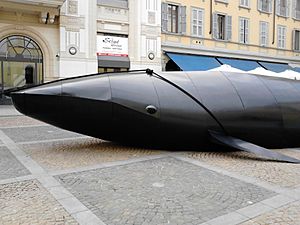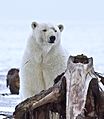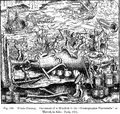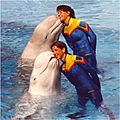Whale facts for kids
Quick facts for kids Whale
An informal group
within the infraorder Cetacea |
|
|---|---|
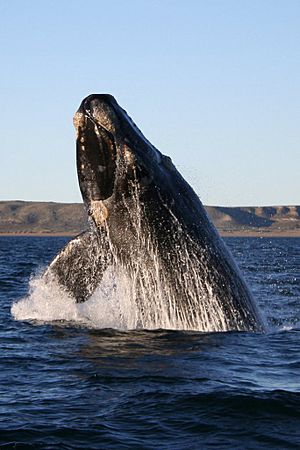 |
|
| Ssouthern right whale | |
| Scientific classification | |
| Kingdom: | Animalia |
| Phylum: | Chordata |
| Class: | Mammalia |
| Order: | Artiodactyla |
| Suborder: | Whippomorpha |
| Infraorder: | Cetacea |
| Groups included | |
|
|
| Cladistically included but traditionally excluded taxa | |
|
|
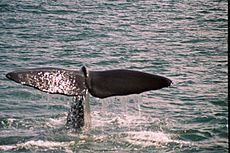
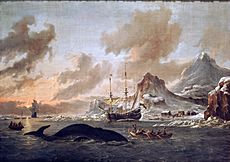
Whales are a large marine mammal species which live in the ocean. Like other mammals, they breathe oxygen from the air, have a small amount of hair, and are warm blooded.
There are two basic kinds of whales, and about 100 species.
People use the word whale in different ways. Some use it for all Cetaceans including dolphins and porpoises. These people say that dolphins and porpoises were also whales, because they are also Cetaceans. Others separate out the dolphins and porpoises: common English-speaking people have never called them or thought of them as whales unless they are very large. Actually, there is no clear line between whales and dolphins.
Whales have been killed for meat and oil by whalers. However, many countries have laws saying not to kill whales anymore. Some countries, such as Iceland and Japan, do not have these laws. In other countries, such as the USA, only Eskimos and some American Indians may legally kill whales such as the blue whale and beluga whale.
Contents
Diet
Baleen whales eat plankton and krill. Plankton are clouds of very small fish floating in the water. The whales' mouths are very large. They open their mouths very wide and hold a big mouthful of sea water. Their throats stretch very wide to make the space inside their mouth even bigger. Then they close their mouth and squeeze out the seawater. The food does not escape because, instead of teeth, these whales have filters called baleen. Baleen is long, hard strips that act like a strainer. The water goes through the baleen. Animals and plants in the water are trapped and swallowed, while the water goes back out. This is very different from the way that toothed whales eat.
Toothed whales eat larger fish or meat and are like big dolphins. They have sharp teeth and usually have a big forehead. Inside the big forehead is a chamber to make and direct sounds. They make all kinds of sounds, including sounds so loud they can shock fish. They can use echolocation to locate things that they can not see. Some toothed whales, such as the sperm whale, are almost never called dolphins. Some of them are always called dolphins. Others are like dolphins in some ways and like whales in others.
Taxonomy
Cetaceans are divided into two suborders:
- The largest suborder, Mysticeti (baleen whales) are characterized by baleen, a sieve-like structure in the upper jaw made of keratin, which it uses to filter plankton from the water.
- Odontoceti (toothed whales) bear sharp teeth for hunting. Odontoceti also include dolphins and porpoises.
Both cetaceans and artiodactyl are now classified under the super-order Cetartiodactyla, which includes both whales and hippopotamuses. Whales are the hippopotamus's closest living relatives.
Evolution
All cetaceans, including whales, dolphins and porpoises, are descendants of land-living mammals of the Artiodactyl order (even-toed ungulates). Both are related to Indohyus (an extinct semi-aquatic deer-like ungulate) from which they split around 54 million years ago. Primitive whales probably first took to the sea about 50 million years ago and became fully aquatic about 5-10 million years later. Pakicetus is an important transitional species.
Scientists from the University of Plymouth studied many animals that dive and hold their breath, from insects to whales, and they found that larger animals can hold their breath longer than smaller animals because they can store more oxygen for their size, and this difference was much bigger for warm-blooded animals than for cold-blooded animals. They said this may be why modern whales and extinct diving animals like plesiosaurs became so large.
Physiology
Because of where they live (and unlike many animals), whales are conscious breathers: they decide when to breathe. Whales breathe through blowholes. Baleen whales have two and toothed whales have one. These are on the top of the head: the animal breathes while most of their body is underwater. Breathing first shoots out extra water from the blowhole, making a jet into the air, followed by inhaling air into the lungs.
All mammals sleep, including whales, but they cannot stay in an unconscious state for too long, because they need to be conscious to breathe. It is thought that only one hemisphere (half) of their brains sleeps at a time, so that whales are never completely asleep, but still get the rest they need. Whales are thought to sleep around eight hours a day.
A baby whale is called a "calf". One calf is born every two or three years. Gestation takes up to a year. Nursing continues for more than a year in many species; there is a strong bond between mother and calf. Reproductive maturity occurs at seven to ten years. This mode of reproduction produces few offspring, but increases their chance of surviving. The effect of hunting is severe on these animals, who replace their numbers slowly.
Whale behavior
Communication
Some species, such as the humpback whale, communicate using melodic sounds, known as whale song. These sounds may be extremely loud, depending on the species. Humpback whales only have been heard making clicks, while toothed whales use sonar that may generate up to 20,000 watts of sound (+73 dBm or +43 dBw) and be heard for many miles.
Captive whales have occasionally been known to mimic human speech. Scientists have suggested this indicates a strong desire on behalf of the whales to communicate with humans, as whales have a very different vocal mechanism, so imitating human speech likely takes considerable effort.
Whales emit two distinct kinds of acoustic signals, which are called whistles and clicks.
Socialization
Whales are known to teach, learn, cooperate, scheme, and even grieve. Small whales are known to engage in complex play behaviour, which includes such things as producing stable underwater toroidal air-core vortex rings or "bubble rings". They also appear to enjoy biting the vortex-rings, so that they burst into many separate bubbles and then rise quickly to the surface. Some believe this is a means of communication. Whales are also known to produce bubble-nets for the purpose of foraging.
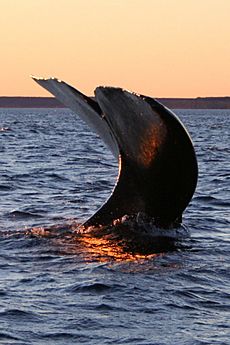
Larger whales are also thought, to some degree, to engage in play. The southern right whale, for example, elevates their tail fluke above the water, remaining in the same position for a considerable amount of time. This is known as "sailing". It appears to be a form of play and is most commonly seen off the coast of Argentina and South Africa. Humpback whales, among others, are also known to display this behaviour.
Breaching
Breaching is what happens when a whale jumps into the air and then purposefully flops down on the water with a great splash. Sometimes it twirls in the air when it does this. Scientists are not sure whether breaching is done to play, to clean the whale's skin of things that are stuck to it, or to tell other whales something.
There are a number of other behaviors on the surface which are not well understood. 'Logging' is when a whale swims slowly at the surface of the ocean with very little movement. When a whale does this, it looks like a log in the water. Some scientists think this is a kind of rest or sleep for whales. 'Spyhopping' is when a whale sits straight up in the water with its head straight up and out of the water. It will sometimes turn around in circles as it spyhops. Some scientists think this might be because whales are trying to see what is happening above water. 'Lobtailing' is done when a whale faces downward in the water. It then slaps the water with a thunderous sound. Scientists think this might be done to warn other whales of danger, or as a method of feeding.
Related pages
Images for kids
-
Basilosaurus skeleton
-
Features of a blue whale
-
Skeleton of a bowhead whale; notice the hind limb. Richard Lydekker, 1894
-
Biosonar by cetaceans
-
A southern right whale sailing
-
Polar bear with the remains of a beluga
-
Whale watching off Bar Harbour, Maine
-
Illustration by Gustave Doré of Baron Munchausen's tale of being swallowed by a whale. While the Biblical Book of Jonah refers to the Prophet Jonah being swallowed by "a big fish", in later derivations that "fish" was identified as a whale.
-
Beluga whales and trainers in an aquarium
See also
 In Spanish: Balénidos para niños
In Spanish: Balénidos para niños


